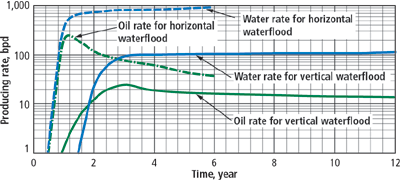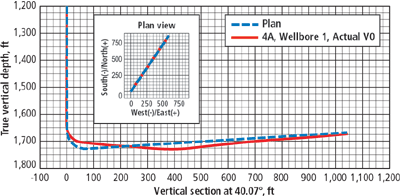|
| |
|

By Petroleum Technology Transfer Council |
Horizontal waterflooding increases injectivity and accelerates recovery
A northeast Oklahoma operator has completed an injector and two producers with horizontal wells in the shallow Bartlesville Sandstone to identify cost-effective short-radius drilling techniques, and strong present-value economic improvements
R. V. Westermark, Grand Directions, S. Robinowitz, Grand Resources, Inc., and H. V. Weyland, US Department of Energy
Grand Resources is applying horizontal waterflooding in northeast Oklahoma's Bartlesville Sandstone to realize much higher injectivity, improved sweep and accelerated recovery. The combined effect should improve present value (PV10) over five-fold, compared to conventional vertical waterflooding. Grand has successfully drilled an injection and two production wells using short-radius drilling techniques.
Real-time learning and innovation proved effective in controlling costs. Initial injection, which is just now beginning, confirms higher injectivity. More time, but not many months, is needed to realize the oil production response that simulation predicts.
HISTORICAL NE OKLAHOMA OIL PRODUCTION
The Bartlesville formation in northeast Oklahoma has been very prolific, producing more than 1.6 billion barrels of oil. However, the recovery efficiency of both primary and secondary production has averaged a low 20% of the original oil in place (OOIP). Primary recovery is low due to: 1) a solution gas-drive mechanism, which results in rapid pressure depletion; and 2) low initial reservoir pressure – a consequence of the shallow depth.
Secondary recovery operations are often neither effective nor economic due to shallow depth, existence of natural fractures, and low matrix permeability. Operators frequently perform fracture treatments on the injection wells and inject water above the reservoir's fracture-parting pressure to achieve better injectivity. The result is often unfavorable since the water tends to channel through the fractures, bypassing much of the remaining oil.
PILOT FIELD TEST IN OSAGE COUNTY
Horizontal waterflooding, as applied in this project, consists of one horizontal injection well and two adjacent, parallel horizontal producing wells. The basic concept is that large volumes of water can be injected at pressures below the fracture-parting pressure of the reservoir. The horizontal producing wells can, in turn, capture the oil that has been mobilized. Simulation studies for thicker sand sections indicate that optimum performance can be achieved by placing horizontal injection wells near the bottom of the formation, with horizontal producers located near the top. Good vertical permeability is required.
A suitable test site was identified in Wolco field, Section 25 T25N R11E. Simulation studies confirmed site suitability and optimum well placement. The Bartlesville Sandstone at this site has an average thickness of 85 ft, porosity in the range of 16% to 20%, and estimated permeability of 30 mD to 100 mD. Based on simulation studies, the horizontal injection well should be drilled 20 ft from the bottom of the sand, while the two producing wells should be placed 20 ft from the top of the sand. Production rates predicted from reservoir simulation, Fig. 1, illustrate the much quicker and higher oil production from horizontal waterflooding. However, a large amount of water will be produced, which must be considered in surface-facility design.
 |
Fig. 1. Comparison of simulation results for vertical and horizontal waterfloods.
|
|
DRILLING TECHNIQUE
Cost-effective drilling operations are the cornerstone of this horizontal water-flooding program. Rock mechanics studies indicated that the matrix of this Pennsylvanian formation has the strength and competency to allow for open-hole completions, which keeps completion costs lower.
Directional drilling uses the rotary drilling system developed and licensed by BP. Simply put, this system comprises two drilling assemblies: a curve drilling assembly (CDA) and the lateral drilling assembly. The CDA drills a very predictable curve of a designed turning radius based on tool configuration. Then the CDA is removed from the well and the lateral drilling assembly is run to drill the desired horizontal well section.
Drilling operations are illustrated with Wolco 4A data. The vertical portion was drilled to a TD of 1,628 ft. The 5 1/2-in. production casing was run to 1,627 ft, and cement was circulated to surface. The CDA was picked up, run into the well, and oriented with a gyroscopic surveying tool. The 90° curve was drilled per the well plan from 1,635 ft to 1,743 ft, maintaining the desired direction as planned. This portion was drilled using water as the circulating medium.
The lateral section was drilled circulating with air/foam to minimize formation damage to the low-pressured reservoir. Two different lateral drilling assemblies were used for drilling the horizontal section. A modified air-hammer, bottomhole assembly was first run in the well; but a correction run was necessary as the air-hammer assembly was dropping angle too quickly.
After the correction run, a packed-hole rotary drilling system was used, with frequent surveys taken to check for proper wellbore direction and inclination. The packed bottomhole assembly held the desired inclination angle and direction, and the well was drilled to a measured depth of 2,732 ft. Directional plots compare actual results vs. the well plan, Fig. 2
 |
Fig. 2. Directional plots for Wolco 4A well.
|
|
LOGGING SHORT-RADIUS WELLS
Grand Resources has developed a method to log horizontal wells through short radius curves by deploying logging tools via sucker rods. The gamma ray, density, induction and borehole televiewer logs were run to determine fluid saturations, identify fractures and confirm geology through the horizontal section of Wolco 4A. Logs were run into the horizontal wellbore section about 500 ft.
Friction and flexibility of the sucker rods prevented the logs from going farther. To overcome the distance limitation of the sucker rod-conveyed logging technique, work is progressing on using a tractor to log up to 2,500 ft of lateral wellbore through short-radius curves.
PROJECT ECONOMICS
Three Bartlesville Sandstone horizontal wells were drilled in the following sequence – Wolco 4A, 6A and 5A. A continual improvement process of well planning, drilling, and a detailed operations review proved to be an effective method to apply lessons learned from each well drilled. These methods resulted in each successive well being drilled more efficiently – and therefore more cost effectively – than the last. Well costs were $257,000; $214,000; and $202,000, respectively, compared to about $98,000 for a typical vertical well.
Simulation results, coupled with an economic evaluation, indicate that a horizontal waterflood on 23-acre spacing would generate $2.9-million cumulative revenue over six years of operation, compared to $1.4-million cumulative revenue over 30 years of operation for a five-spot vertical waterflood. Present values (PV10) for horizontal and vertical waterfloods in Wolco field are $2.3 million and $0.4 million, respectively, representing more than a five-fold improvement.
PRODUCTION RESULTS
Pumping units have been installed on the two producing wells. Insert pumps in the 2 7/8 -in. tubing are set in the vertical well section, placing the pump inlets 90 ft above the horizontal section. The producing wells began pumping in early January 2004. The injection well, Wolco 4A, was completed with a packer in the 5 1/2 -in. casing in the vertical well section, with 2 7/8 -in. internally coated tubing.
Water injection began on December 30, 2003, at 2,000 bwpd, which is being injected at zero surface pressure. This provides an initial injectivity substantially greater than the historical injectivity of former vertical injection wells in the area adjacent to and south of the Wolco pilot area. More time, but only in the order of months, will be required before production response should occur. 
ACKNOWLEDGMENT
Work is being accomplished within a cost-shared project in DOE's Native American program.
THE AUTHORS
|
| |
R.V. “Bob” Westermark is president of Grand Directions, a subsidiary of Grand Resources, Inc. He is also an instructor for OGCI, teaching classes in Managing Wellsite Operations and Well Engineering. He recently managed a DOE-sponsored research project using vibration stimulation for enhancing oil recovery. He managed Amoco's Catoosa Research facility after working 24 years for various producing companies in locations around the world. Mr. Westermark holds a BS degree in petroleum engineering from Montana Tech. Contact: bob@grandoil.com.
|
|
Scott Robinowitz, vice president, Grand Resources, Inc., has experience in reservoir engineering and modeling, well completions, equipment design, field operations, environmental compliance and technology integration. He has worked with Grand Resources since 1999. He holds an MS degree in environmental engineering from Oklahoma State University and a BS degree in mechanical engineering from Tulane University. Contact: scott@grandoil.com.
|
| |
Helen Virginia (Ginny) Weyland, a graduate of Texas A&M University, has worked for the US Department of Energy since 1982. She was stationed at the Naval Petroleum Reserve in California and served as geologist and subcommittee chair for the Shallow Oil Zone, the largest producing reservoir at Elk Hills oil field. She transferred to Tulsa to become a project manager for the National Energy Technology Lab in 1997. She works cross-cutting disciplines such as enhanced oil recovery and advanced diagnostics and imaging, as well as research for independent oil operators. Ms. Weyland is best known for her work on the Native American Initiative. Contact: virginia.weyland@netl.doe.gov.
|
|




